Project Management Assignment:TFL Plan for the staging of William G. Gilbert & Arthur Sullivan
Question
Task:
Project Management Assignment Task:
Case Study
Dear Consultant,
A recent permission granted by Ealing Council to Transport for London (TfL) to develop some of our Land along Bollo Lane to create more than 800 new homes in Acton. Transport for London aim to undertake road projects to create safer, greener and more attractive streets, as well as improve the entire bus network across London – Ealing Council. Following this approval, TfL are inviting project management plan for the staging of one of the famous operettas of playwright William G. Gilbert and composer Arthur Sullivan to be submitted for consideration. The event is also aimed at celebrating the 40th anniversary of G&S Society and to unveil TfL strategic direction. The event will be funded by TfL in collaboration with the University’s Student Council. I wanted to thank you for taking on this contract at short notice, but to express my confidence in your ability to provide Transport for London project management plan.
You are to assume that it is 27th of September 2021, the Monday of the first week of the project. While the project team is being formed, the Project Manager asks you to prepare a 1500 (+/-10%) word report to be with him on 12th November 2021 and which he can present to TfL and the University’s Student Council.
The title of the report is “TfL project management plan for the staging of one of the famous operettas of playwright William G. Gilbert and composer Arthur Sullivan”.
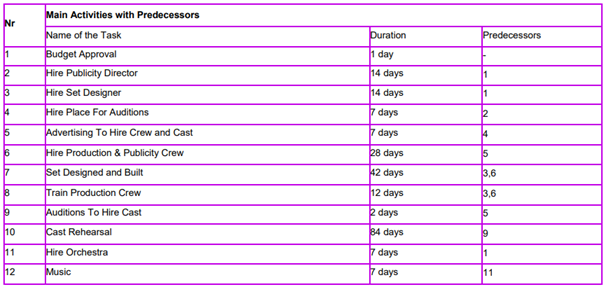
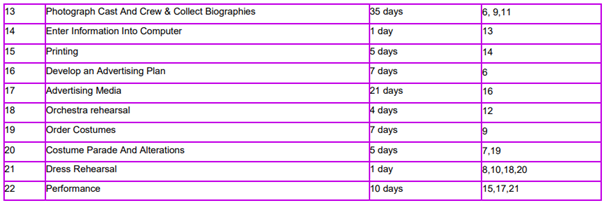
Task 1
1) The project management plan must begin by providing a justification for the project i.e. A compelling business case – project objectives and deliverables. Followed by a critical analysis of what methodology would be appropriate for this project and why? Support just justification with examples of where this methodology has been previously used as well as the benefits of using this methodology in your project.
Task 2
2) (i) Develop a network diagram manually, AS TAUGHT (activities on arrows) clearly showing the relationship between all the activities listed above, the dependencies, the likely duration for each activity, the likely completion date (expected total project time). Calculate the earliest starting time, the latest starting time (EST,LST) and the earliest finishing time and latest finishing time (EFT, LFT) for each activity including an outline description of the critical path, highlighting the critical activities and the shortest possible time in days in which the project can be completed as scoped above. (give reasons for your choice). (ii) Using microsoft project i.e. MS Project, represent the activity list above in a Gantt Chart.
Task 3
3) Undertake a stakeholder analysis for this project. This should clearly identify internal and external stakeholder, group stakeholders according to their interest and power i.e. stakeholder management matrix, communication strategies.
Task 4
4) Using the activity list above, develop a clearly numbered Work Breakdown Structure (WBS) alongside an organizational structure for this music event.
Task 5
5) You are required to prepare a Risk Analysis for 20 different risks that could affect your project. Analyse the risks involved and develop strategies for dealing with them in detail. Present your Risk Analysis and Risk Management strategies/mitigations in the form of a table, AS TAUGHT in class.
Task 6
6) You are required to determine what the quality expectation, acceptance criteria, quality specification, and what measures would be put in place to control the event. In other words you write up in this section must cover these heading.
Answer
Introduction
The following report on project management assignment gives an elaboration of the components of a project which involves creating a business case that explains the main objective of the project along with specifying the deliverables. The use of a specific project methodology would also be mentioned to ensure that the authorities of the TFL can analyse the perception of the project team. The next segment of the project will focus on manual network diagrams followed by stakeholder analysis. The stakeholder analysis would help in developing the web breakdown structure which would effectively help in recognising the risks associated with individual work and creating a risk management strategy as a part of the report. Finally, an elaboration of the quality expectations and acceptance would be explained.
Business case
Project objectives
The objective of the project is to organise an event while celebrating the 40th anniversary of G&N society while unveiling the strategic direction of transport for London which would engage in initiating Road projects while creating safer, attractive and greener streets which would influence the complete bus network of Ealing Council.
Deliverables
The prime deliverables of the project are to successfully organise the event while stating the famous operettas of playwright William G. Gilbert and composer Arthur Sullivan. The deliverables also include the celebration of the 40th anniversary of G&S Society while launching the strategy direction finalised by TFL.
Methodology
Waterfall is the most effective project methodology that can be used in the project launched by TFL as it focuses on testing and deployment after one another which helps in following the structured organisational approach. One of the examples of waterfall methodology is The projects executed by development of Department of defence weather agencies typically used a waterfall model which helps in having a compatible view of the entire project (Torok, 2020).
Benefits of methodology
The main advantages of using the waterfall model are that it is easy to use and explain to the client while receiving approval regarding the management of the rigid model where each phase focuses on certain deliverables. The prime advantage of waterfall methodology is that new faces can overlap while completing the entire project one activity at a time.
Network diagram and Gantt chart
Gantt chart
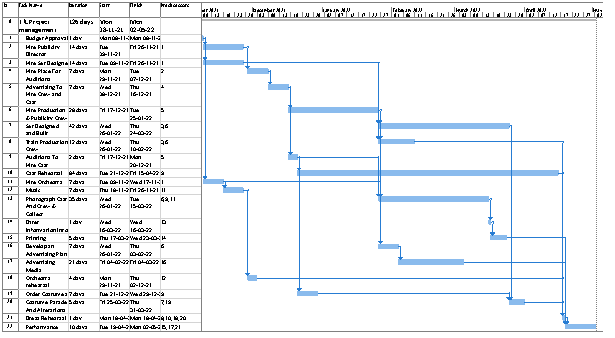
Figure 1: Gantt Chart
(Source: Made by Author)
Critical path
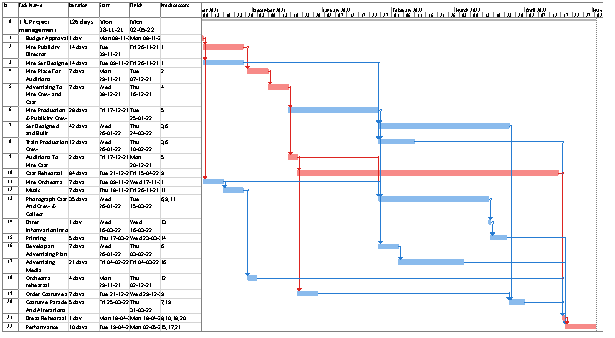
Figure 2: Critical Path
(Source: Created by Author)
Network diagram
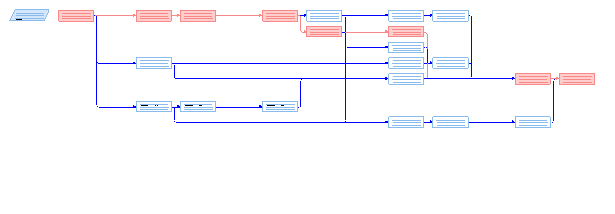
Figure 3: Network Diagram
(Source: Created by Author)
Task List
|
Task Name |
Duration |
Start |
Finish |
Predecessors |
|
TfL Project management plan |
126 days |
Mon 08-11-21 |
Mon 02-05-22 |
|
|
Budget Approval |
1 day |
Mon 08-11-21 |
Mon 08-11-21 |
|
|
Hire Publicity Director |
14 days |
Tue 09-11-21 |
Fri 26-11-21 |
1 |
|
Hire Set Designer |
14 days |
Tue 09-11-21 |
Fri 26-11-21 |
1 |
|
Hire Place For Auditions |
7 days |
Mon 29-11-21 |
Tue 07-12-21 |
2 |
|
Advertising To Hire Crew and Cast |
7 days |
Wed 08-12-21 |
Thu 16-12-21 |
4 |
|
Hire Production & Publicity Crew |
28 days |
Fri 17-12-21 |
Tue 25-01-22 |
5 |
|
Set Designed and Built |
42 days |
Wed 26-01-22 |
Thu 24-03-22 |
3,6 |
|
Train Production Crew |
12 days |
Wed 26-01-22 |
Thu 10-02-22 |
3,6 |
|
Auditions To Hire Cast |
2 days |
Fri 17-12-21 |
Mon 20-12-21 |
5 |
|
Cast Rehearsal |
84 days |
Tue 21-12-21 |
Fri 15-04-22 |
9 |
|
Hire Orchestra |
7 days |
Tue 09-11-21 |
Wed 17-11-21 |
1 |
|
Music |
7 days |
Thu 18-11-21 |
Fri 26-11-21 |
11 |
|
Photograph Cast And Crew & Collect Biographies |
35 days |
Wed 26-01-22 |
Tue 15-03-22 |
6,9,11 |
|
Enter Information Into Computer |
1 day |
Wed 16-03-22 |
Wed 16-03-22 |
13 |
|
Printing |
5 days |
Thu 17-03-22 |
Wed 23-03-22 |
14 |
|
Develop an Advertising Plan |
7 days |
Wed 26-01-22 |
Thu 03-02-22 |
6 |
|
Advertising Media |
21 days |
Fri 04-02-22 |
Fri 04-03-22 |
16 |
|
Orchestra rehearsal |
4 days |
Mon 29-11-21 |
Thu 02-12-21 |
12 |
|
Order Costumes |
7 days |
Tue 21-12-21 |
Wed 29-12-21 |
9 |
|
Costume Parade And Alterations |
5 days |
Fri 25-03-22 |
Thu 31-03-22 |
7,19 |
|
Dress Rehearsal |
1 day |
Mon 18-04-22 |
Mon 18-04-22 |
8,10,18,20 |
|
Performance |
10 days |
Tue 19-04-22 |
Mon 02-05-22 |
15,17,21 |
Stakeholder analysis
The internal stakeholders for the project initiated by TFL involves the current employees working for TFL, the entire project team who is responsible for hiring further experts such as such a designer, publicity director and production and publicity crew. The internal stakeholders also involve the local authorities who sanctioned the budget finalised by the project team.
The external stakeholders involve the audience of the state show, the publicity director, the set designer, the manager of the auditorium booked for the event, the production and publicity crew and all the team members who would be working together to execute the entire project and ensure that it is successfully delivered by 12th November 2021.
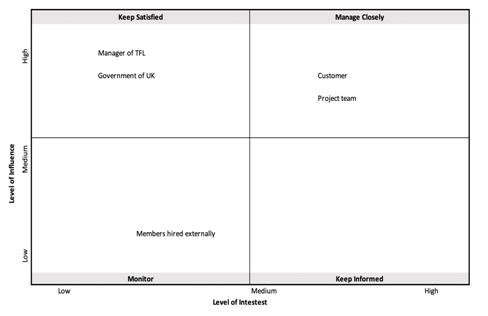
Figure 4: Stakeholder analysis grid
(Source: Created by author)
The above table gives a brief explanation of all the stakeholders while mentioning that the internal stakeholders are the prime stakeholders who need to be satisfied as a priority. The above mentioned internal stakeholders Including the government authorities and the managers of TFL who need to be kept satisfied as they have high power however low interest in the project. The local government holds the power to maintain the flow of financial assets that is necessary for continuing with the project (Rai, Verlinde and Macharis, 2018). The internal stakeholder, the customers and the project team need to be managed closely as they are the promoter of the project and have a strong implication over the successful delivery of the event because they have increased interest and high power over the entire project. From the perception of external stakeholders, the project team including all the external members hired to execute the project needs to be informed about all the progress as they have high interest but low power (Raum, 2018). Therefore, it can be confirmed that the external stakeholders have maximum interest in the project however low power because they are hired by the client to look into the expectations of the client and deliver the project accordingly.
Work breakdown structure
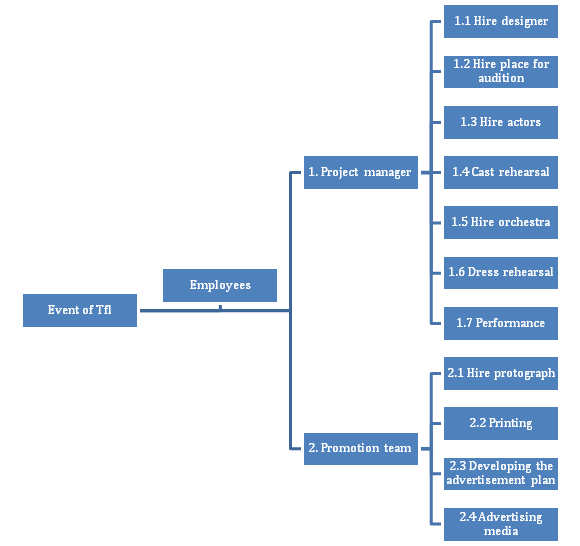
Figure 5: Work breakdown structure
(Source: Created by author)
The above mentioned image gives a clear elaboration of the job responsibilities that would be considered by their TFL project management team who would hire different professionals to ensure that the project is launched in a large scale so that it has the opportunity to unveil all of its strategies regarding the development of the new bus route in Ealing Council (Elsye, Latief and Sagita,2018). The table gives a better elaboration of all the responsibilities assigned to the individual managers who would look into their external affairs such as hiring the cast along with the entire crew responsible for production as well as public city because the promotion of the plays critical were the greater number of audiences would imply to a greater success of the event organised by TfL.
Risk analysis
|
Risk |
Description |
Likelihood |
Severity |
Risk score |
Mitigation |
|
R1 |
Lack of well-defined purpose of the project |
3 |
5 |
15 |
Increase the training of the project team to develop proper document specifying the purpose of the project |
|
R2 |
Incomplete recognition of the project design and deliverables |
3 |
6 |
18 |
Execute official meeting with the management authorities of TFL preparing a list of design and deliverables |
|
R3 |
Lack of well-structured project schedule based on the given timeframe |
2 |
5 |
10 |
Hire skilled employees having experience in working in project management |
|
R4 |
Lack of skills in the team hired to execute the event |
1 |
6 |
6 |
Hire skilled employees having experience in working in project management |
|
R5 |
Delay in delivery of the props that would be used in the event |
2 |
5 |
10 |
Hire skilled employees having experience in working in project management |
|
R6 |
Error in estimation while preparing the budget |
4 |
6 |
24 |
Execute official meeting with the management authorities of TFL |
|
R7 |
Unplanned activity that needs to be included in the midway of the event |
3 |
5 |
15 |
Execute official meeting with the management authorities of TFL |
|
R8 |
Inappropriate clarification about the responsibility creating a confusion |
5 |
4 |
20 |
Hire skilled employees having experience in working in project management |
|
R9 |
Increased pressure on the employees without informing them about the need of the project |
1 |
6 |
6 |
|
|
R10 |
Unplanned functionalities added by the client prior to the execution of the project |
2 |
5 |
10 |
Execute official meeting with the management authorities of TFL |
|
R11 |
Internal conflict among the team members who are supposed to work together |
2 |
5 |
10 |
|
|
R12 |
Unplanned climatic changes demolishing the venue chosen for the event |
2 |
6 |
12 |
Execute official meeting with the management authorities of TFL |
|
R13 |
Inappropriate procurement of the resources leading to the delay in execution of the event |
3 |
5 |
15 |
Execute official meeting with the management authorities of TFL |
|
R14 |
Implementation of new policy by the government of UK influencing the operation of TFL |
4 |
5 |
20 |
Execute official meeting with the management authorities of TFL |
|
R15 |
Inappropriate promotional strategies failing to reach the expected audience |
5 |
4 |
20 |
Execute official meeting with the management authorities of TFL |
|
R16 |
Complication due to legal permission |
5 |
6 |
30 |
Receive all the legal approval before executing the project |
|
R17 |
Non-acceptance by the current management team of TFL due to issue in quality |
4 |
5 |
20 |
Execute official meeting with the management authorities of TFL |
|
R18 |
Criminal activities such as theft of props and materials |
2 |
6 |
12 |
Increase the security of the area while posting a security guard to look into the props |
|
R19 |
Delay in delivery of the responsibilities assigned to the employees such as the promotional strategy |
5 |
6 |
30 |
Hire skilled employees having experience in working in project management |
|
R20 |
Act of God such as sudden extreme weather |
1 |
5 |
5 |
Execute official meeting with the management authorities of TFL |
Quality expectations
The quality expectations in walls having a definite number of audiences as per the seats available in the venue. The chosen criteria for acceptance involve that all the audience are aware of the upcoming event. The quality specification involves following the risk register and attempting to implement the mitigation activities. The measures which would be used to put in the control of the event involves continuous focus over the activities executed by the team.
Conclusion
The evaluation of the entire project helps in concluding that the development of the project objective is quite clear which specifies the deliverables that would be available for the management team of TFL who are planning to publicly announce their strategy decisions. The network diagram along with the Snapchat gives an elaborated timeline. It can be concluded that the development of the stakeholder analysis provided an opportunity to segregate the power of the internal and external stakeholders while recognising their interest and power over the entire project. The structure and the risk analysis help in recognising all the associated risk which needs to be mitigated to ensure that the project is completed on time.
Reference list
Elsye, V., Latief, Y. and Sagita, L., (2018). Development of work breakdown structure (WBS) standard for producing the risk based structural work safety plan of building. In MATEC Web of Conferences (Vol. 147, p. 06003).EDP
Sciences.https://www.matec-conferences.org/articles/matecconf/pdf/2018/06/matecconf_sibe2018_06003.pdf
Rai, H.B., Verlinde, S. and Macharis, C., (2018). Shipping outside the box.Environmental impact and stakeholder analysis of a crowd logistics platform in Belgium. Project management assignment Journal of Cleaner Production, 202,
pp.806816.https://www.researchgate.net/publication/327157585_ Shipping_outside_the_box_Environmental_impact_and_stakeholder_analysis_of_a_ crowd_logistics_platform_in_Belgium
Raum, S., (2018). A framework for integrating systematic stakeholder analysis in ecosystem services research: Stakeholder mapping for forest ecosystem services in the UK. Ecosystem services, 29, pp.170-184. https://www.sciencedirect.com/science/article/pii/S2212041617304989
Torok, R.J., (2020). Using Model-Based Systems Engineering Methods to Capture a Department of Defense Acquisition Life Cycle. Naval Postgraduate School.https://apps.dtic.mil/sti/pdfs/AD1127128.pdf












